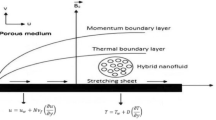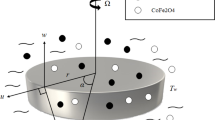Abstract
The purpose of this paper is to theoretically investigate the steady nanofluid flow due to a permeable stretching/shrinking cylinder using the mathematical nanofluid model proposed by Buongiorno. The effects of the stretching/shrinking parameter as well as the suction and curvature parameters are studied. A similarity transformation is used to reduce the governing partial differential equations to a set of nonlinear ordinary (similarity) differential equations which are then solved numerically using the function bvp4c from Matlab for different values of the governing parameters. It is found that the solution is unique for stretching case; however, multiple (dual) solutions exist for the shrinking case. A closed form analytical solution is also obtained when the curvature parameter α = 0. For α small (α ≪ 1) dual solutions exist for both stretching and shrinking cylinder, while for α large (α ≫ 1) dual solutions are found only for the shrinking cylinder(λ < 0).














Similar content being viewed by others
Abbreviations
- a :
-
radius of the cylinder
- C :
-
nanoparticle volume fraction
- C ∞ :
-
ambient nanoparticle volume fraction
- c p :
-
specific heat due to constant pressure
- D B :
-
Brownian diffusion coefficient
- D T :
-
thermophoretic diffusion coefficient
- k :
-
thermal conductivity of the nanofluid
- l :
-
characteristic length
- Nb :
-
Brownian motion parameter
- Nt :
-
thermophoresis parameter
- Nu x :
-
local Nusselt number
- Pr :
-
Prandtl number
- q w :
-
heat flux from the surface of the cylinder
- Re x :
-
local Reynolds number
- S :
-
suction/injection parameter
- Sc :
-
Schmidt number
- T :
-
temperature of the nanofluid
- T w :
-
temperature at the surface of the cylinder
- T ∞ :
-
temperature of the ambient fluid
- u :
-
velocity along the x axis
- v :
-
velocity along the r axis
- uw(x):
-
stretching/shrinking velocity
- u 0 :
-
characteristic velocity
- (x, r):
-
axial coordinate x and radial coordinate r normal to the x
- α :
-
curvature parameter
- λ :
-
constant shrinking/stretching parameter
- ρ :
-
density of the nanofluid
- (ρcp)f :
-
heat capacity of the base fluid
- (ρcp)p :
-
effective heat capacity of the nanoparticles
- υ :
-
kinematic coefficient of viscosity of nanofluid
- η :
-
similarity variable
- θ :
-
dimensionless temperature
- φ :
-
dimensionless rescaled nanoparticle volume fraction
- τ w :
-
skin frictions or shear stresses in the x - direction of the stretching/shrinking cylinder
- γ :
-
nanoparticle heat capacity ratio
References
Choi SUS (1995) Enhancing thermal conductivity of fluids with nanoparticles. In: Proceedings of the 1995 ASME International Mechanical Engineering Congress and Exposition, FED 231/MD 66 (19550), 99–105
Choi SUS, Zhang ZG, Yu W, Lockwood FE, Grulke EA (2001) Anomalous thermal conductivity enhancement on nanotube suspensions. Appl Phys Lett 79:2252–2254
Hosseini SSA (2009) Nano-fluids and heat transfer engineering, 1st edn. Yazda, Tehran
Patel HE, Das SK, Sundararajan T, Sreekumaran A, George B, Pradeep T (2003) Thermal conductivities of naked and monolayer protected metal nanoparticle based nanofluids: manifestation of anomalous enhancement and chemical effects. Appl Phys Lett 83:2931–2933
You SM, Kim JH, Kim KH (2003) Effect of nanoparticles on critical heat flux of water in pool boiling heat transfer. Appl Phys Lett 83:3374–3376
Khanafer K, Vafai K, Lightstone M (2003) Buoyancy-driven heat transfer enhancement in a two dimensional enclosure utilizing nanofluids. Int J Heat Mass Transf 46:3639–3653
Tiwari RK, Das MK (2007) Heat transfer augmentation in a two-sided lid-driven differentially heated square cavity utilizing nanofluids. Int J Heat Mass Transf 50:2002–2018
Oztop HF, Abu-Nada E (2008) Numerical study of natural convection in partially heated rectangular enclosures filled with nanofluids. Int J Heat Fluid Flow 29:1326–1336
Sheremet MA, Pop I (2014) Thermo-bioconvection in a square porous cavity filled by oxytactic microorganisms. Transp Porous Media 103:191–205
Sheremet MA, Groşan T, Pop I (2014) Freeconvection in shallow and slender porous cavities filled by a nanofluid using Buongiorno’s model. ASME J Heat Transfer 136:082501
Sheremet MA, Groşan T, Pop I (2015) Free convection in a square cavity filled with a porous medium saturated by nanofluid using Tiwari and Das’ nanofluid model. Transp Porous Media 106:595–610
Buongiorno J (2006) Convective transport in nanofluids. ASME J Heat Transfer 128:240–250
Revnic C, Abu-Nada E, Groşan T, Pop I (2018) Natural convection in a rectangular cavity filled with nanofluids: effect of variable viscosity. Int J Numer Method Heat Fluid Flow 28:1410–1432
Das SK, Choi SUS, Yu W, Pradeep Y (2008) Nanofluids: science and technology. Wiley, New Jersey
Nield DA, Bejan A (2013) Convection in porous media, 4th edn. Springer, New York
Minkowycz WJ, Sparrow EM, Abraham JP (eds) (2013) Nanoparticle heat transfer and fluid flow. CRC Press, Taylor & Fracis Group, New York
Shenoy A, Sheremet M, Pop I (2016) Convective flow and heat transfer from wavy surfaces: viscous fluids, porous media and Nanofluids. CRC Press, Taylor & Francis Group, New York
Buongiorno J et al (2009) A benchmark study on the thermal conductivity of nanofluids. J Appl Phys 106:1–14
Kakaç S, Pramuanjaroenkij A (2009) Review of convective heat transfer enhancement with nanofluids. Int J Heat Mass Transf 52:3187–3196
Manca O, Jaluria Y, Poulikakos D (2010) Heat transfer in nanofluids. Adv Mech Eng 2010:380826
Mahian O, Kianifar A, Kalogirou SA, Pop I, Wongwises SA (2013) A review of the applications of nanofluids in solar energy. Int J Heat Mass Transf 57:582–594
Sheikholeslami M, Ganji DD (2016) Nanofluid convective heat transfer using semi analytical and numerical approaches: a review. J Taiwan Inst Chem Eng 65:43–77
Myers TG, Ribera H, Cregan V (2017) Does mathematics contribute to the nanofluid debate ? Int J Heat Mass Transf 111:279–288
Mahian O et al (2019) Recent advances in modeling and simulation of nanofluid flows—part I: fundamentals and theory. Phys Rep 790:1–48
Mahian O et al (2019) Recent advances in modeling and simulation of nanofluid flows—part II: applications. Phys Rep 791:1–59
Fisher EG (1976) Extrusion of plastics. Wiley, New York
Crane LJ (1970) Flow past a stretching plate. Z Angew Math Mech (ZAMM) 21:645–647
Banks WHH (1983) Similarity solutions of the boundary-layer equations for a stretching wall. J Mech Theor Appl 2:375–392
Mcleod B, Rajagopal KR (1987) On the uniqueness of the flow of a Navier-stokes fluid due to stretching boundary. Arch Ration Mech Anal 98:385–393
Miklavčič M, Wang CY (2006) Viscous flow due to a shrinking sheet. Q Appl Math 64:283–290
Fang T (2008) Boundary layer flow over a shrinking sheet with power-law velocity. Int J Heat Mass Transf 51:5838–5843
Fang TG, Zhang J, Yaho SS (2009) Viscous flow over an unsteady shrinking sheet with mass transfer. Chin Phys Lett 26:0147031-4
Goldstein J (1965) On backward boundary layers and flow in converging passages. J Fluid Mech 21:33–45
Wang CT (2011) Review of similarity stretching exact solutions of the Navieer-stokes equations. Eur J Mech B Fluids 30:475–479
Wang CY (2012) Natural connvection on a vertical stretching cylinder. Commun Nonlinear Sci Numer Simul 17:1098–1103
Wang CY (2007) Stagnation flow on a cylinder with partial slip-an exact solution of the Navier–stokes equations. IMA J Appl Math 72:271–277
Hayat T, Ijaz Khan M, Waqas M, Alsaedi A (2017) Newtonian heating effect in nanofluid flow by a permeable cylinder. Results Phys 7:256–262
Revnic C, Grosan T, Merkin JH, Pop I (2009) Mixed convection flow near an axisymmetric stagnation point on a vertical cylinder. J Eng Math 64:1–13
Vajravelu K, Rollings D (2004) Hydromagnetic flow of a second grade fluid over a stretching sheet. Appl Math Comput 148:783–791
Cortell R (2006) Flow and heat transfer of an electrically conducting fluid of second grade over a stretching sheet subject to suction and to a transverse magnetic field. Int J Heat Mass Transf 49:1851–1856
Merkin JH, Najib N, Bachok N, Ishak A, Pop I (2017) Stagnation-point flow and heat transfer over an exponentially stretching/shrinking cylinder. J Taiwan Inst Chem Eng 74:65–72
Kuznetsov AV, Nield DA (2010) Natural convective boundary-layer flow of a nanofluid past a vertical plate. Int J Therm Sci 49:243–247
Shampine LF, Reichelt MW, Kierzenka J (2010) Solving boundary value problems for ordinary differential equations in Matlab with bvp4c. <http://www.mathworks.com/bvp_tutorial>
Roşca NC, Pop I (2013) Mixed convection stagnation point flow past a vertical flat plate with a second order slip: heat flux case. Int J Heat Mass Transf 65:102–109
Roşca AV, Pop I (2013) Flow and heat transfer over a vertical permeable stretching/shrinking sheet with a second order slip. Int J Heat Mass Transf 65:355–364
Ghalambaz M, Doostani A, Izadpanahi E, Chamkha AJ (2017) Phase-change heat transfer in a cavity heated from below: the effect of utilizing single or hybrid nanoparticles as additives. J Taiwan Inst Chem Eng 72:104–115
Acknowledgements
The work of N.C. Roşca, A.V. Roşca and I. Pop has been supported from the grant PN-III-P4-ID-PCE-2016-0036, UEFISCDI, Romania. The authors wish also to express their thanks to the very competent Reviewers for the valuable comments and suggestions.
Author information
Authors and Affiliations
Corresponding author
Ethics declarations
Conflict of interest
On behalf of all authors, the corresponding author states that there is no conflict of interest.
Additional information
Publisher’s note
Springer Nature remains neutral with regard to jurisdictional claims in published maps and institutional affiliations.
Rights and permissions
About this article
Cite this article
Roşca, N.C., Roşca, A.V., Pop, I. et al. Nanofluid flow by a permeable stretching/shrinking cylinder. Heat Mass Transfer 56, 547–557 (2020). https://doi.org/10.1007/s00231-019-02730-x
Received:
Accepted:
Published:
Issue Date:
DOI: https://doi.org/10.1007/s00231-019-02730-x




